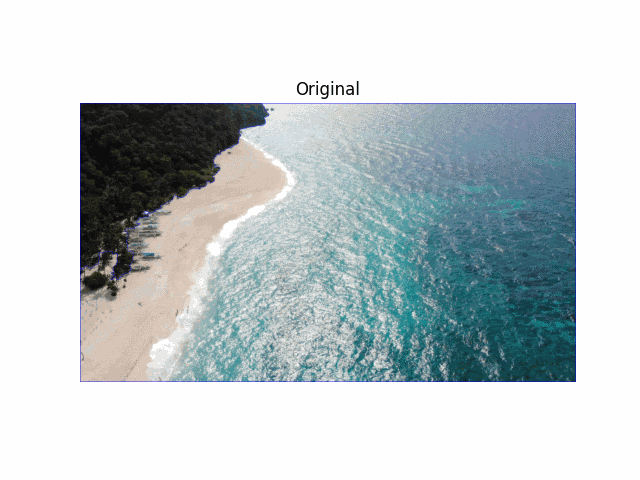原理
泛洪填充算法和分水岭算法是图像处理中的两种重要算法,主要用于区域分割,但它们的原理和应用场景有所不同,但是他们的基础思想都是基于区域迭代实现的区域之间的划分。
泛洪算法
泛洪填充算法(Flood Fill)是一种经典的图像处理算法,用于确定和标记与给定点连接的区域,通常在图像填充、分割、边界检测等方面应用广泛。为了更直观地理解泛洪填充算法,我们可以通过一系列生动的图像和步骤来介绍其工作原理。
假设我们有一个二维图像,每个像素可以有不同的颜色或灰度值。泛洪填充算法的目标是从某个起始像素开始,填充所有与其相连且具有相同颜色的像素。常见的应用包括图像编辑中的填充工具(如油漆桶工具)和迷宫求解等。
算法流程
以下是泛洪填充算法的基本步骤,配合图像说明:
选择起始点和目标颜色:
- 选择图像中的一个起始像素点(如鼠标点击的位置),记作 (x, y)。
- 确定要填充的目标颜色。
初始化队列:
- 将起始点 (x, y) 加入队列。
处理队列:
当队列不为空时,重复以下步骤:- 从队列中取出一个像素点 (cx, cy)。
- 如果 (cx, cy) 的颜色等于目标颜色,则进行填充。
- 将 (cx, cy) 的四个邻居(上、下、左、右)加入队列(如果这些邻居还没有被处理过且颜色等于目标颜色)。

分水岭算法
分水岭算法是一种基于形态学和拓扑学的图像分割技术。它将图像视为一个拓扑地形,通过标记图像的不同区域(例如山脉和盆地)进行分割。分水岭算法的基本思想是通过模拟雨水从山顶流向盆地的过程,确定图像中不同区域的边界。
分水岭迭代过程:
- 把梯度图像中的所有像素按照灰度值进行分类,并设定一个测地距离阈值。
- 找到灰度值最小的像素点(默认标记为灰度值最低点),让threshold从最小值开始增长,这些点为起始点。
- 水平面在增长的过程中,会碰到周围的邻域像素,测量这些像素到起始点(灰度值最低点)的测地距离,如果小于设定阈值,则将这些像素淹没,否则在这些像素上设置大坝,这样就对这些邻域像素进行了分类。
- 随着水平面越来越高,会设置更多更高的大坝,直到灰度值的最大值,所有区域都在分水岭线上相遇,这些大坝就对整个图像像素的进行了分区。
实际应用时常结合其他预处理,来实现前后景的分割:
算法流程
梯度计算: 首先计算图像的梯度,梯度可以使用 Sobel 算子或其他方法计算。梯度图像反映了图像中像素值变化的幅度。
其中,𝐼 是原始图像,𝐺是梯度图像。
标记区域: 对图像进行标记,将前景对象和背景标记出来。可以使用形态学操作来获取这些标记。
确定前景:使用距离变换和阈值化来确定前景区域。
确定背景:通过膨胀操作扩展前景区域,从而确定背景区域。
确定未知区域: 未知区域是背景和前景的差集。
连接组件标记: 对前景区域进行连通组件标记,每个连通组件代表一个独立的前景对象。
分水岭变换: 使用分水岭变换对梯度图像进行处理,分割图像中的不同区域。
分水岭变换后,标记图像的边界区域将被标记为 -1。
API介绍
floodfill
int cv::floodFill ( InputOutputArray image, //输入图像
InputOutputArray mask, //输入输出的maks
Point seedPoint, //种子点
Scalar newVal, //信的
Rect * r ect = , 0 // 存储填充区域的边界
Scalar loDiff = , Scalar() // 允许填充的像素值差的下届
Scalar upDiff = , Scalar() // 允许填充的像素值差的上届
int flags = 4 // 4联通或8联通
) import cv2
import numpy as np
import matplotlib.pyplot as plt
def main():
# 加载图像
image_path = 'D:\code\src\code\lena.jpg' # 替换为你的图像路径
image = cv2.imread(image_path)
if image is None:
print("Error: Unable to load image.")
return
# 定义种子点和新颜色
seed_point = (30, 30) # 替换为你希望的种子点 (x, y)
new_color = (0, 0, 255) # 新颜色为绿色 (B, G, R)
# 创建掩码,比原图多出两行两列
mask = np.zeros((image.shape[0] + 2, image.shape[1] + 2), np.uint8)
# 设置差值范围
lo_diff = (10, 10, 10)
up_diff = (10, 10, 10)
image_src = image.copy()
# 执行泛洪填充
flags = 4 # 4-连通
num, im, mask, rect = cv2.floodFill(image, mask, seed_point, new_color, lo_diff, up_diff, flags)
# 显示填充后的图像
plt.subplot(131),plt.imshow(image_src[...,::-1]),plt.title('Source Image'), plt.xticks([]), plt.yticks([])
plt.subplot(132),plt.imshow(mask[...,::-1]),plt.title('Mask Image'), plt.xticks([]), plt.yticks([])
plt.subplot(133),plt.imshow(image[...,::-1]),plt.title('Filled Image'), plt.xticks([]), plt.yticks([])
plt.show()
if __name__ == '__main__':
main()
watermeshed
cv::watershed ( InputArray image, //输入图像
InputOutputArray markers //输入出的标记
)
//即根据传入的确信区域以及原图,经过分水岭迭代后,得到的确信区域import cv2
import numpy as np
import matplotlib.pyplot as plt
import imageio
def plot_image(image, title, save_path):
plt.imshow(cv2.cvtColor(image, cv2.COLOR_BGR2RGB))
plt.title(title)
plt.axis('off')
plt.savefig(save_path)
plt.close()
def save_gif(frames, filename, duration=0.5):
imageio.mimsave(filename, frames, duration=duration)
def watershed_segmentation(image_path):
# Read the image
image = cv2.imread(image_path)
gray = cv2.cvtColor(image, cv2.COLOR_BGR2GRAY)
# Apply thresholding
ret, thresh = cv2.threshold(gray, 0, 255, cv2.THRESH_BINARY_INV + cv2.THRESH_OTSU)
# Noise removal with morphological operations
kernel = np.ones((3, 3), np.uint8)
opening = cv2.morphologyEx(thresh, cv2.MORPH_OPEN, kernel, iterations=2)
# Sure background area
sure_bg = cv2.dilate(opening, kernel, iterations=3)
# Finding sure foreground area
dist_transform = cv2.distanceTransform(opening, cv2.DIST_L2, 5)
ret, sure_fg = cv2.threshold(dist_transform, 0.7 * dist_transform.max(), 255, 0)
# Finding unknown region
sure_fg = np.uint8(sure_fg)
unknown = cv2.subtract(sure_bg, sure_fg)
# Marker labelling
ret, markers = cv2.connectedComponents(sure_fg)
# Add one to all labels so that sure background is not 0, but 1
markers = markers + 1
# Now, mark the region of unknown with zero
markers[unknown == 255] = 0
# Apply watershed
markers = cv2.watershed(image, markers)
image[markers == -1] = [255, 0, 0] # Mark boundaries with red color
# Collect frames for GIF
frames = []
for step in ['Original', 'Threshold', 'Morph Open', 'Sure BG', 'Sure FG', 'Unknown', 'Markers', 'Watershed']:
if step == 'Original':
frame = image.copy()
elif step == 'Threshold':
frame = cv2.cvtColor(thresh, cv2.COLOR_GRAY2BGR)
elif step == 'Morph Open':
frame = cv2.cvtColor(opening, cv2.COLOR_GRAY2BGR)
elif step == 'Sure BG':
frame = cv2.cvtColor(sure_bg, cv2.COLOR_GRAY2BGR)
elif step == 'Sure FG':
frame = cv2.cvtColor(sure_fg, cv2.COLOR_GRAY2BGR)
elif step == 'Unknown':
frame = cv2.cvtColor(unknown, cv2.COLOR_GRAY2BGR)
elif step == 'Markers':
frame = np.zeros_like(image)
for i in range(1, ret + 1):
frame[markers == i] = np.random.randint(0, 255, size=3)
elif step == 'Watershed':
frame = image.copy()
frame_path = f"{step.lower().replace(' ', '_')}.png"
plot_image(frame, step, frame_path)
frames.append(imageio.imread(frame_path))
return frames
# Main execution
image_path = 'D:\code\src\code\R-C.png' # Replace with your image path
frames = watershed_segmentation(image_path)
save_gif(frames, 'watershed.gif', duration=1000)

参考链接
OpenCV(26)图像分割 -- 距离变换与分水岭算法(硬币检测、扑克牌检测、车道检测)_分水岭算法分割咖啡豆-CSDN博客
图像处理之漫水填充算法(flood fill algorithm)-腾讯云开发者社区-腾讯云 (tencent.com)
